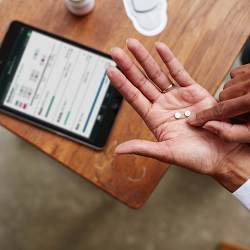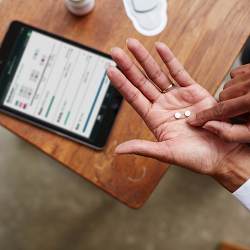
The rapid growth of utilitarian mobile platforms has not left the field of medicine behind, with apps being introduced ranging from mobile-friendly reference platforms to apps that enable users to track their activity and diet.
One glaring shortcoming has endured in mobile health: empirically quantified data from inside a patient’s body. A medication diary or reminder app does no good if the patient lies about taking his or her medicine, or forgets to look at their phone. Such nonadherence is incredibly expensive; researchers from Johns Hopkins University estimated recently between 25% and 50% of U.S.-based patients do not adhere to prescribed medication regimens, leading to $100-300 billion of avoidable health care costs annually.
New technologies that allow clinicians to receive information directly from the human body are about to hit the market, however, ushering in a new era of quantifiable data collection with minimal human effort required. The first generation of these technologies are single-purpose, single-use circuits are poised for production.
The next generation of multi-purpose ingestible technologies, which might enable more granular biometrics and controlled medication release, is emerging in proof-of-concept studies and inspiring wide-ranging research discussions.
Sand-Grain Sized Transmitters
First-generation ingestible transmitters are exemplified by Redwood City, CA-based Proteus Digital Health, developer of a system including an ingestible sensor, a patch worn on the patient’s body, and corresponding smartphone app that can communicate the patient’s status to treating clinicians. The sensor, the size of a grain of sand, is constructed of minute quantities of copper and magnesium (trace minerals found in the human diet), which are combined in a gel capsule with the patient’s medication. Once ingested, the sensor’s electrolyte coating interacts with the electrolytes found in the patient’s stomach fluid to form a biogalvanic battery. The battery’s current creates an electrical field that propagates through body tissues to the skin surface, where it is detected, decoded, recorded, and date- and time-stamped by the patch, before transmitting the sensor’s data, complete with a unique identifier, to the companion phone app. The sensor eventually passes through the user’s intestine and out of the body.
The system was approved by the U.S. Food and Drug Administration (FDA) in 2012, and an FDA decision on the platform’s first combination with a drug, Otsuka Pharmaceutical’s psychiatric drug Abilify, is expected by April.
"The first digital medicine will be treating patients suffering from serious mental illness and those struggling with adhering to their medication regimen," Proteus spokeswoman Martina Dach said. "Proteus and Otsuka believe that the need in this area is great, this digital medicine can change the way adherence is measured, and we have the potential to fulfill a serious unmet medical need in this population."
Albert Swiston, a biomaterials scientist at the Lincoln Laboratory at the Massachusetts Institute of Technology (MIT), called the Proteus approach a "beautiful system."
"Technically and scientifically, it’s a wonderful little system." Swiston said. "It’s really tiny but it does one very simple thing, and for the application they’re addressing, it’s perfect."
Next-Gen Research Emerges
Swiston is on the forefront of the next generation of ingestible micro-devices, devices envisioned to fulfill more than one task – or a single task at selected intervals, such as staggered and controlled medication release – within the human gastrointestinal (GI) tract. Swiston and colleagues from MIT, Harvard University, and Massachusetts General Hospital recently published in PLOS One the results of a proof-of-concept study testing the ability of a capsule-sized device to measure and report heart and respiratory rate from inside the GI tract (the study was conducted on pigs). The experiment’s results have helped the team expand on the technology’s purpose – including data on core temperature is also high on the team’s list of desired output – as well as modifying some of the technology contained within the capsule. For instance, Swiston said the team has eliminated miniature microphones as transmitting devices in favor of hydrophones.
"It may sound similar, but in fact the electronics behind it are not," he said. "It’s essentially sonar. Your body is mostly water, so you have to do what is called acoustic impedance matching. You want to match your impedances because then you have less loss, and we found hydrophones were the best for that."
Swiston said the device that eventually emerges from his lab could be used for niche applications like collecting vital signs on a patient whose skin cannot be touched, or post-surgery monitoring for incipient infection.
"Right now, the bill of materials is about $70, and that’s cost-prohibitive for everyday use," he said. "But if you’re considering a monitoring device after a $50,000 hip replacement, it’s trivial. You match the weapon to the battle."
Another team of researchers at Vanderbilt University’s Science and Technology of Robotics in Medicine (STORM) Lab hopes to lower the cost of developing ingestible devices by providing fundamental building blocks as an open source platform.
STORM Lab director Pietro Valdastri said his team has developed a flexible circuit that folds down to 14 millimeters in length, capable of housing five modules that measure and report on different functions, as well as a 25-item library of those modules.
"Let’s say you want an inertial sensor to understand the inclination of the capsule, or to operate a motor to release a drug," Valdastri said. "From our library a researcher can pick a wireless connection module, a micro-controller module that can be programmed, an inertial sensor, and motor-driving module, put them together on our flexible circuit, and then design the outer shell of the capsule and go directly to the prototype stage."
Powering Devices An Issue
One of the most perplexing issues facing next-gen ingestible products is how to adequately power multi-purpose devices that may have to remain within a GI tract longer than single-use reporting devices. Swiston said his device, for instance, has a 1-5-milliamp requirement for a device that could spend "up to three days of being inside you, and you have to duty-cycle it a certain way, turning different sensors on and off. You don’t want to use the radio constantly, because that is a real power hog."
Christopher Bettinger, an assistant professor of materials science and biomedical engineering at Carnegie Mellon University, said his lab is focusing on biocompatible and biodegradable materials that could significantly reduce the risk associated with repeated ingestion of these devices, with power issues one of the first to be addressed.
"We are focusing on using biologically-derived materials and structures that can replace traditional materials for the battery, packing, logic, and so on," he said, adding that his lab is addressing the power issue by experimenting with melanin electrodes in various configurations for a device’s cathode and anode. As for the electrolyte, he said his team plans to use gastric fluids, as used by Proteus.
Valdastri said power issues in ingestible devices are vexing enough that he is eschewing wireless technology in the near term for what he hopes will be something quicker to receive regulatory approval and clinical use. His lab is developing a "soft tethered" capsule meant to replace the traditional scope used for colonoscopies. The 4-millimeter-wide tether is about half the diameter of the current state of the art, and the capsule containing the camera, while as wide as the traditional scope, is only 3 centimeters long, which Valdastri said will eliminate the need to anesthetize the patient. The design will also make it much easier for the operating clinician to avoid difficulty in navigating the intestines. The capsule, which contains a small magnet, is guided by an external magnet, eliminating the need to push the device through the intestine.
While Valdastri said a large European project in which he was involved failed to result in anything making it to the market, his current projects are receiving support from funding agencies. Additionally, just as Valdastri hoped to foster a spirit of collaboration in open sourcing some of the STORM Lab’s work, others are also open to such an approach.
"These are very interdisciplinary challenges that require collaborations and diverse technical backgrounds," Bettinger said.
Gregory Goth is an Oakville, CT-based writer who specializes in science and technology.




Join the Discussion (0)
Become a Member or Sign In to Post a Comment